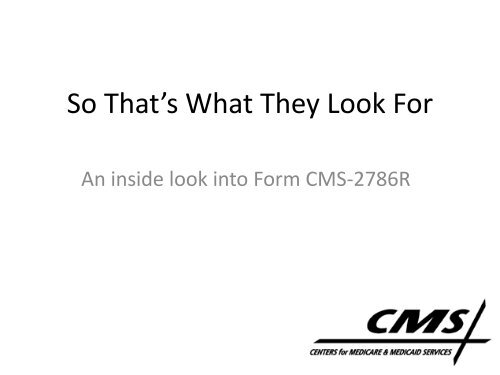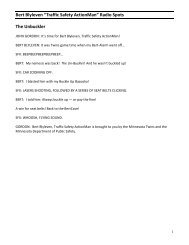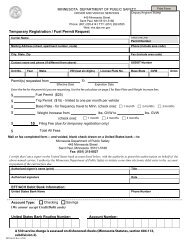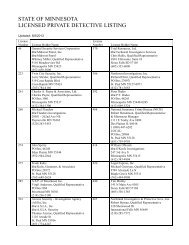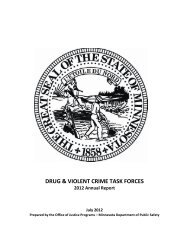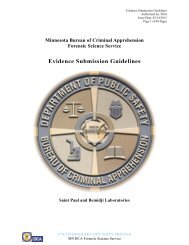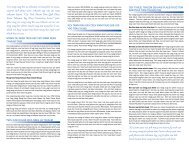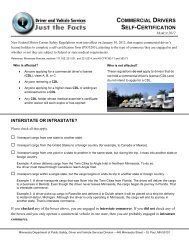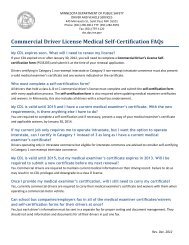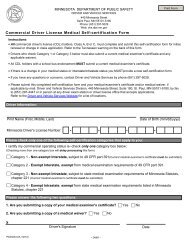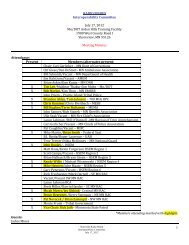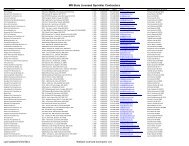So That's What They Look For
So That's What They Look For
So That's What They Look For
Create successful ePaper yourself
Turn your PDF publications into a flip-book with our unique Google optimized e-Paper software.
<strong>So</strong> That’s <strong>What</strong> <strong>They</strong> <strong>Look</strong> <strong>For</strong><br />
An inside look into <strong>For</strong>m CMS-2786R
Agenda<br />
• RO V Life Safety Code staff structure<br />
• Detailed look into CMS-2786R<br />
– Example pictures provided when available<br />
• Annual Waiver Process<br />
• FSES Process
RO LSC Structure<br />
• Safety Engineers<br />
– Stephen Pelinski (312)886-5215<br />
• Surveyor<br />
• IL, MI, MN State Leader<br />
– Bruce Wexelberg (312)353-2859<br />
• Surveyor<br />
• IN, OH, WI State Leader<br />
• LSC Principal Program Representative (PPR)<br />
– Daniel Kristola<br />
• Annual waiver and FSES reviewer
K11 – Fire Barriers<br />
• Fire barriers are the fire resistance rated (FRR)<br />
walls that separate the nursing home from a<br />
nonconforming building.<br />
• The walls must be at least 2hr FRR.<br />
• A fire barrier could also be a rated wall that<br />
separates two portions of the nursing home.<br />
• The wall will be inspected for proper<br />
construction and to ensure that all<br />
penetrations are properly firestopped.
K11 – Fire Barriers Cont.<br />
• All doors in the fire barrier will also be<br />
inspected.<br />
• Doors must have labels to show they are at<br />
least 90min FRR.<br />
• Doors must self-close and latch into the frame.<br />
• If double doors, there must be an astragal at<br />
the meeting edge of doors.<br />
• Hold open devices must release upon<br />
activation of the fire alarm system.
K12 – Construction Type<br />
• NFPA 101 Tables 18.1.6.2 and 19.1.6.2 list<br />
acceptable construction types.<br />
• Tables are broken down into five construction<br />
types.<br />
– Type I and II – noncombustible<br />
– Types III, IV, and V – combustible<br />
• K12 takes construction materials, fire ratings,<br />
sprinkler coverage, and number of stories into<br />
consideration.
K12 – Construction Type Cont.<br />
• 19.1.6.2 contains construction types that are<br />
acceptable without a complete sprinkler<br />
system.<br />
• All nursing homes, regardless of construction<br />
type, must be completely sprinklered by Aug.<br />
13, 2013.
K103 – Interior Wall Construction<br />
• Interior walls in Type I and II buildings must be<br />
constructed of noncombustible or limitedcombustible<br />
material.<br />
– Essentially saying wood should not be used as a<br />
construction material in a noncombustible<br />
building.
K14/K15 – Interior Finish<br />
• Flame spread rating documentation is needed for any<br />
interior finish applied to walls that is more than 1/28 th<br />
of an inch thick.<br />
• The flame spread rating must be from a test conducted<br />
in accordance with NFPA 255.<br />
– Mostly a concern when carpet has been installed on walls.<br />
Carpet is typically tested as a floor application in<br />
accordance with NFPA 253.<br />
• NFPA 253 and NFPA 255 are NOT equivalent.<br />
• Flame retardant agents can be applied to achieve an<br />
acceptable flame spread rating.<br />
– Agent must be listed for use with material on which it will<br />
be applied.
K16 – Interior Finish<br />
• Interior finish requirements for floor finishes.<br />
• Only required for newly installed floor finishes<br />
in nonsprinklered areas.<br />
– Newly installed – Any floor finish installed after<br />
March 13, 2003.
K17 – Corridor Walls<br />
• Corridor walls must extend to the underside of<br />
the roof or floor above in areas that are not fully<br />
sprinklered and the walls must have at least a<br />
30min FRR.<br />
• Corridor walls can terminate at a monolithic<br />
ceiling in an area that is not fully sprinklered.<br />
– The entire smoke compartment must have the<br />
monolithic ceiling to use this exception<br />
• Corridor walls can terminate at a smoke resisting<br />
ceiling in a fully spinklered area.
K17 – Corridor Walls Cont.<br />
• There are eight exceptions for existing health<br />
care for spaces that are allowed to be open to<br />
the corridor.<br />
• Most common errors in applying the<br />
exceptions:<br />
– Space is used for patient treatment (Therapy<br />
Rooms)<br />
– Space does not have 24hr supervision<br />
– Space is used for storage that is deemed<br />
hazardous
K17 – Corridor Walls Cont.<br />
• Openings in corridor walls cannot exceed<br />
20sqin (80sqin in fully sprinklered areas).<br />
• Openings created by sliding glass windows fall<br />
under same criteria and openings are<br />
measured when window is fully open.<br />
– Does not apply to a sliding glass window at a<br />
nurses station<br />
– Space open to the corridor exceptions can be<br />
applied for a sliding glass window to a receptionist<br />
area
K17 – Corridor Walls Cont.<br />
• Kitchen to dining room pass through windows are<br />
acceptable if the dining room is separated from<br />
the corridor by acceptable walls.<br />
• These pass through windows may not be<br />
acceptable if the dining room is open to the exit<br />
access corridor.<br />
– Space open to the corridor exceptions cannot be<br />
applied to the Kitchen.<br />
– To keep the pass through, the opening must be<br />
protected in a manner that would automatically close<br />
the opening upon the local detection of smoke or<br />
activation of the fire alarm system.
K17 – Corridor Walls Cont.<br />
• Transfer grilles are not acceptable in corridor<br />
walls.<br />
– Dampers do not make transfer grilles permissible
K18 – Corridor Doors<br />
• Corridor doors must have at least a 20min FRR in an<br />
area that is not fully sprinklered.<br />
– Labeled door<br />
– 1.75in solid core wood door<br />
– Door frames must also be FRR or metal<br />
• Corridor doors must resist the passage of smoke.<br />
– CMS S&C Memo 07-18<br />
• Not fully sprinklered – No more than .25in gap between the door<br />
jamb and face of door<br />
• Fully sprinklered – No more than .5in gap between the door<br />
jamb and face of door<br />
• Door jamb acts as an astragal, so the door cannot sag below the<br />
jamb
K18 – Corridor Doors Cont.<br />
• Other common deficiencies with corridor doors<br />
– Doors held open by devices that do not release with<br />
a push or pull of the door.<br />
• Kick-stop, wedge, furniture, etc.<br />
• A magnetic hold-open, friction catch, or closer-brake are<br />
acceptable examples.<br />
• Doors do not latch or lack a latching device.
K22 – Exit Signs<br />
• Access to exits must be indicated by appropriate<br />
exit signs when the path to the exit is not obvious.<br />
– Directional arrows incorrectly direct evacuees<br />
• When a door that is not an emergency exit but it is<br />
obvious that it leads outside the door must be<br />
marked with a “NO EXIT” sign.<br />
– LSC Section 7.10.8.1 specifies the dimensions of the<br />
letters on the signs and the language<br />
– Existing signs do not need to meet 7.10.8.1 if<br />
acceptable to AHJ
K20 – Vertical Openings<br />
• Vertical openings must be enclosed with at<br />
least 1hr FRR construction.<br />
– LSC Section 8.2.5.4, existing enclosures in existing<br />
buildings have a 1/2hr FRR, does not apply because<br />
the occupancy chapter requirement supersedes it.<br />
• Doors in vertical openings must have a 1hr FRR,<br />
must be self-closing, and must normally be kept<br />
closed.
K20 – Vertical Openings Cont.<br />
• Enclosure must extend from the bottom to the<br />
top of the building. Otherwise, the top and/or<br />
bottom of the enclosure must be capped with<br />
1hr FRR construction.<br />
– Shaft can terminate in a room related to the use of<br />
the shaft if the room meets all FRR requirements for<br />
vertical openings (Laundry chute termination room)<br />
• Penetrations into vertical openings must be<br />
properly firestopped to maintain the 1hr FRR.
K20 – Vertical Openings Cont.<br />
• FSES and Vertical Openings<br />
– An FSES can be used to achieve compliance in lieu of<br />
correcting some vertical opening related deficiencies<br />
• Enclosures that are not constructed with the proper rating<br />
• Enclosures that are not complete from the bottom of the building<br />
to the top<br />
– An FSES cannot be used to achieve compliance for the lack<br />
of required fire dampers in duct penetrations of vertical<br />
opening enclosure walls. Similarly, an FSES cannot be<br />
used for improper installation of required fire dampers.<br />
• This deficiency is actually an HVAC deficiency out of NFPA 90A<br />
• An FSES fails when there is a lack of compliance with NFPA 90A<br />
(CMS-2786T Table 8.C.)
K21 – Self-Closing Door Hold-Opens<br />
• Doors in exit passageways, stairway enclosures,<br />
horizontal exits, smoke barriers, and hazardous<br />
areas can only be held open by a device that<br />
automatically closes the door upon activation<br />
of one of the following:<br />
– Fire alarm system<br />
– Local smoke detector<br />
– Sprinkler system
K33 – Exit Stairways<br />
• Similar requirements to K20 for stairway enclosure<br />
construction.<br />
• No enclosed useable space within an exit stairway<br />
including under stairs<br />
– Enclosed space is permitted under stairs if the space is<br />
constructed with same FRR of stairway and access to the<br />
space is not from within exit stairway<br />
• Unenclosed spaces within stairway shall not be used for<br />
any purpose that may interfere with egress<br />
– No storage or equipment installation in stairway<br />
– There is no exception to allow storage if the stairway is<br />
protected by sprinklers
K33 – Exit Stairways Cont.<br />
• No storage or equipment installation in stairway<br />
– NFPA A.7.1.3.2.3 – This provision prohibits the use<br />
of exit enclosures for storage or for installation of<br />
equipment not necessary for safety. Occupancy is<br />
prohibited other than for egress, refuge, and access.<br />
The intent is that the exit enclosure essentially be<br />
“sterile” with respect with fire safety hazards
K23/K24 – Smoke Compartmentation<br />
• K23 - There must be a smoke barrier to form at<br />
least two smoke compartments on every<br />
sleeping floor where there are more than 30<br />
residents.<br />
• K24 – Smoke compartment shall not exceed<br />
22,500sqft and travel distance to smoke barrier<br />
door cannot exceed 200ft.
K25 – Smoke Barriers<br />
• Smoke barrier walls must have a 1/2hr FRR.<br />
(1hr FRR for new construction)<br />
• Smoke barriers must be continuous from<br />
outside wall to outside wall or to another<br />
smoke barrier.<br />
• Smoke barrier must be continuous from the<br />
floor to the floor above or the roof.<br />
• Smoke barriers cannot terminate at the bottom<br />
of a roof/ceiling assembly.
K25 – Smoke Barriers Cont.<br />
• Smoke barrier penetrations must be properly<br />
firestopped.<br />
– Existing penetrations must only be smoke tight<br />
– New firestopping must maintain the fire resistance<br />
rating of the smoke barrier by means of a listed<br />
through penetration system<br />
– Noncombustible penetrations can be firestopped with rigid<br />
materials<br />
– Combustible penetrations must be firestopped with through<br />
penetration systems that incorporate intumescent materials<br />
that expand when the penetration burns away
K25 – Smoke Barriers Cont.<br />
• Windows in smoke barriers must be protected<br />
by fire-rated glazing or wired glass and must be<br />
in steel frames.<br />
• K26 – There must be adequate space on each<br />
side of the smoke barrier for residents.<br />
– At least 30sqft per resident in the total of all<br />
corridors, resident rooms, dining rooms, and other<br />
low hazard areas
K27 – Smoke Barrier Doors<br />
• Smoke barrier doors must be 20min FRR<br />
– 1.75in solid bonded wood core can be assumed<br />
20min FRR<br />
• Doors must be self-closing<br />
• Doors that swing in the same direction and<br />
have an astragal shall be equipped with a door<br />
coordinator that will ensure the doors close in<br />
the proper order
K28 – Smoke Barrier Doors<br />
• Smoke barrier doors shall provide clear width of<br />
32in<br />
• Vision panels must have fire rated glazing or<br />
wired glass and must have steel frames
K104 – Smoke Dampers<br />
• Penetrations of smoke barriers by ducts are<br />
protected with smoke dampers<br />
– Not required if the HVAC system and there is a<br />
complete sprinkler system on both sides of the<br />
smoke barrier<br />
• Dampers are required to be inspected and<br />
tested every 4 years<br />
– Recommended every 2 years<br />
– 6 year maintenance waiver only applies to hospitals
K29 – Hazardous Areas<br />
• Nonsprinklered hazardous areas are required to<br />
be separated from other areas by a 1hr FRR<br />
enclosure.<br />
– If ceiling is not 1hr rated, the walls must extend to<br />
the roof.<br />
– Doors are required to be 45min FRR.<br />
– Doors must self-close, latch, and can only be held<br />
open with a device that is compliant with K21
K29 – Hazardous Areas Cont.<br />
• Sprinklered hazardous areas are required to be<br />
separated from other areas by a smoke resisting<br />
enclosure<br />
– If ceiling is not smoke resisting, the walls must<br />
extend to the roof<br />
– Doors are required to be smoke resisting (No<br />
louvers)<br />
– Doors must self-close, latch, and can only be held<br />
open with a device that is compliant with K21
K29 – Hazardous Areas Cont.<br />
• Hazardous Areas may include, but are not<br />
limited to, the following areas:<br />
– Boiler and Fuel-Fired Heater Rooms<br />
– Laundry rooms (Over 100sqft)<br />
– Repair and Paint Shops<br />
– Laboratories (Severe hazard is K31)<br />
– Combustible Storage Rooms (Over 50sqft)<br />
– Trash Collection Rooms<br />
– <strong>So</strong>iled Linen Rooms
K29 – Hazardous Areas in New Construction<br />
• Sprinklers are required in all new construction, so<br />
certain hazardous areas are required to have a 1hr<br />
FRR enclosure in addition to the sprinkler<br />
protection<br />
– Boiler and Fuel Fired Heater Rooms<br />
– Laundry Rooms(Over 100sqft)<br />
– Laboratory(Severe Hazard)<br />
– Paint Shops(Less than Severe Hazard)<br />
– Maintenance Shops<br />
– <strong>So</strong>iled Linen Rooms<br />
– Combustible Storage Rooms(Over 100sqft)<br />
– Trash Collection Rooms
K30 – Gift Shops<br />
• Must be protected as a hazardous area when<br />
used for storage or display of combustibles in<br />
hazardous quantities<br />
• Must have smoke resisting walls if displays are<br />
not in hazardous quantities, have separate<br />
protected storage, and are completely<br />
sprinklered<br />
– Can be open to the corridor if less than 500sqft
K211 – Alcohol Based Hand<br />
Rubs(ABHR)<br />
• Where ABHR dispensers are installed:<br />
– The corridor must be at least 6ft wide<br />
– Maximum capacity per dispenser is .3gal(.5gal in<br />
suites of rooms) – 1.2L and 2.0L<br />
– Minimum 4ft spacing between dispensers<br />
– No more than 10gal(37.8L) in one smoke<br />
compartment
K211 – ABHR Cont.<br />
• Where ABHR dispensers are installed:<br />
– Storage of quantities greater than 5gal(18.9L) must<br />
meet requirements of NFPA 30<br />
– Dispensers are not installed over or adjacent to an<br />
ignition source<br />
• Light switch, electrical outlet, electrical equipment, etc.<br />
• No measurements to define distances<br />
• If adjacency is in question, look for evidence of splash from<br />
ABHR<br />
– If floor is carpeted, building must be fully sprinklered
K32 - Exits<br />
• Not less than two exits are provided for each<br />
floor or smoke compartment in a building<br />
– One of two required exits may be a horizontal exit<br />
– Evacuation from a smoke compartment through a<br />
door that is not a direct exit shall not require<br />
returning to the smoke compartment of fire origin to<br />
reach a direct exit
K34 – Means of Egress (Stairways)<br />
• Stairways and smokeproof towers must:<br />
– Meet dimension standards of LSC Table 7.2.2.2.1(a)<br />
or (b)<br />
– Be constructed with completely noncombustible<br />
construction in Type I or II buildings<br />
– Have guards when more than 30in above grade or<br />
floor below(Also applies to ramps)<br />
• At least 42in high<br />
• Must have intermediate rails that would stop a 4in sphere
K34 – Means of Egress (Stairway) Cont.<br />
• Stairways and smokeproof towers must:<br />
– Have handrails installed between 34in and 38in that<br />
extend for the entire stairway(Also applies to ramps)<br />
• Existing handrails permitted down to 30in<br />
• New handrails have many requirements regarding shape,<br />
size, continual graspability, etc.<br />
• Single steps or ramps from a sidewalk to a vehicular way<br />
are not required to have handrails<br />
– More requirements at LSC Section 7.2.2 and 7.2.3
K35 – Means of Egress (Exit Width)<br />
– Requirements specific to health care<br />
• .6in per person for exit stairs (.3in in fully sprinklered<br />
buildings)<br />
• .5in per person for doors, ramps, horizontal exits (.2in in fully<br />
sprinklered buildings)<br />
– Other areas must meet general requirements in<br />
Section 7.3<br />
• Means of egress must be sufficient for occupant load of story<br />
or other occupied space<br />
– Capacity calculations are based on evacuation of one story at a time<br />
– Converging means of egress must be sufficient to accommodate<br />
both means of egress from the convergence point
K36 – Means of Egress (Travel Distance)<br />
– Travel distance measured in accordance with Section<br />
7.6<br />
• Measured on the floor, along natural path of travel(closest<br />
exit), curving around corners with 1ft clearance, and<br />
ending at the center of the door<br />
– Travel distance from exit access door to exit shall not<br />
exceed 100ft (150ft in fully sprinklered building)<br />
– Travel from any point in a room to an exit shall not<br />
exceed 150ft (200ft in fully spinklered building)<br />
– Travel from any point in a suite to an exit access door<br />
shall not exceed 100ft
K37 – Means of Egress (Dead-end<br />
Corridors)<br />
– Existing dead-end corridors are permitted if it is<br />
impractical to alter them<br />
– Dead-end corridors cannot exceed 30ft in new<br />
construction<br />
• Cannot create a new dead-end corridor that exceeds 30ft<br />
when altering a facility’s evacuation plan
K38 – Means of Egress (Accessability)<br />
– Walking surface must be level, clear, and<br />
unobstructed at all times and useable under all<br />
weather conditions<br />
• Storage not permitted in corridors<br />
• Abrupt changes in elevations shall not exceed 1/4in<br />
– Under 1/2in can be beveled<br />
– Over 1/2in must be corrected by other means<br />
• Snow, ice, water, soft ground are examples of impediments<br />
that can obstruct egress by individuals that use walkers,<br />
wheelchairs, or require other forms of assistance
K38 – Means of Egress (Painted Doors)<br />
– Exit doors or exit access doors cannot be<br />
painted/disguised in a manner that obscures their<br />
use as a door<br />
• A door that contains a window and has a compliant exit<br />
sign above the door can be painted if a cognitively aware<br />
individual can still tell it’s an exit door<br />
• The window cannot be painted<br />
– This may also be cited at K72
K38 – Means of Egress (Locked Doors)<br />
– Special locking arrangements are permitted under<br />
certain circumstances in health care facilities<br />
• Locks are permitted on doors in a means of egress if<br />
residents have a clinical need for the extra security<br />
measures<br />
– Door lock regulations also pertain to gates in the means of egress<br />
• Magnetic locks must release upon activation of fire alarm<br />
or loss of power<br />
• Doors can be locked from the outside to prevent<br />
unauthorized entry without obstructing egress
K38 – Means of Egress(Locked Doors<br />
Cont.)<br />
– Special units – All residents have clinical needs<br />
• All egress doors can be locked<br />
• All staff members that work in that unit must have the<br />
knowledge and ability to unlock doors<br />
– All staff must have keys (A single key at a nurses station is not<br />
acceptable), or<br />
– All staff must know code and know how to use keypad<br />
– Mixed Population – Not all residents have clinical needs<br />
• Doors can be locked, but staff, visitors, and residents without<br />
clinical needs must have ability to use doors
K38 – Means of Egress(Locked Doors<br />
Cont.)<br />
– Delayed-egress locks<br />
• Permitted on all doors regardless of clinical needs of<br />
residents<br />
• Delay of 15 seconds permitted after pressure applied to<br />
door for no more than 3 seconds (30 sec delay exception)<br />
• Doors must have signs that read:<br />
– PUSH UNTIL ALARM SOUNDS DOOR CAN BE OPENED IN 15<br />
SECONDS<br />
• No more than one delayed-egress lock in means of egress<br />
– Including gates
K38 – Means of Egress(Locked Doors Cont.)<br />
– Delayed-egress locks Cont.<br />
• Locks are permitted if the building has either:<br />
– A complete fire detection system in accordance with LSC Section<br />
9.7<br />
– A complete automatic sprinkler system in accordance with LSC<br />
Section 9.6<br />
– Sensor-controlled locks must meet delayed-egress<br />
lock requirements if they lock in that manner<br />
– Deadbolt locks are not permitted unless the deadbolt<br />
releases with the same action of the door handle
K39 – Means of Egress (Corridor Width)<br />
– Width of exit access corridors or aisles must be at<br />
least:<br />
• 4ft in existing health care<br />
• 8ft in new health care<br />
– Measured at the narrowest point<br />
– The constructed width must be kept clear<br />
• Not permissible to have 2ft of storage in a 6ft wide corridor<br />
in an existing building<br />
– Projections less than 3.5in shall be permitted at 38in<br />
and below<br />
• S&C Memo 04-41 – Wall mounted touch screens
K40 – Means of Egress (Door Width)<br />
– Exit access doors and exit doors must be swinging<br />
doors and are:<br />
• At least 32in in clear width in existing buildings<br />
– Existing 34in doors that have less than 32in clear width<br />
– Existing 28in doors where fire plan does not require evacuation by<br />
bed, gurney, or wheelchair<br />
• At least 41.5in in clear width in new buildings<br />
– 32in in exit stairway enclosures
K41/K42 – Means of Egress (Exit Access Doors)<br />
– K41 - All resident rooms have a door to a corridor or<br />
directly to grade<br />
• There can be one intervening room between the resident room<br />
and the exit access corridor<br />
– Cannot be hazardous<br />
– K42 – Any resident room or suite of resident rooms larger<br />
than 1000sqft have at least 2 exit access doors remote<br />
from each other<br />
• 2500sqft when non-resident room suites<br />
• Remote is ½ the measurement of the largest diagonal distance in<br />
the room<br />
– 1/3 in fully sprinklered building
K43 – Means of Egress (Exit Access)<br />
– Resident room doors shall not require a key to open<br />
from the egress side
K44 – Means of Egress (Horizontal Exit)<br />
– Not less than 30sqft per resident available on the<br />
other side of the horizontal exit<br />
• Occupiable spaces are permitted for calculation<br />
– Horizontal exit doors are not required to swing with<br />
egress travel in existing buildings<br />
– Horizontal exit doors must be swinging with 32in<br />
clear width<br />
• Horizontal sliding doors meeting Section 7.2.1.14 with 32in<br />
clear width also permitted
K45 – Normal Illumination<br />
– All portions of the means of egress must have<br />
continuous illumination that:<br />
• Cannot be controlled by manual switches<br />
– Motion sensors are permitted if they are equipped with fail-safe<br />
and are set to at least 15min interval<br />
• Is at least 1ft-candle measured at the floor<br />
• Failure of one-single bulb cannot leave an area with less<br />
than .2ft-candle of illumination<br />
• Have a reliable power source<br />
– Battery-operated, portable lamps, or lanterns are not permitted to<br />
be the primary illumination source of the means of egress
K46 – Emergency Illumination<br />
– All portions of the means of egress must have emergency<br />
illumination that:<br />
• Cannot be controlled by manual switches<br />
– Motion sensors are permitted if they are equipped with fail-safe and are set to at<br />
least 15min interval<br />
• Provides required levels of illumination for 90min<br />
• Is at least on average 1ft-candle measured at the floor and not less than<br />
.1ft-candle at any point<br />
– .6ft-candle average and .06ft-candle at any point at 90 th minute<br />
• Failure of one-single bulb cannot leave an area with less than .2ft-candle of<br />
illumination<br />
– Battery-operated emergency lights must be tested:<br />
• Monthly for 30sec<br />
• Annually for 90min<br />
• Individual results for all lights must be on the records
K47 – Exit Signs<br />
– Exit signs or directional signs must mark exits or the<br />
path to exit<br />
• Not required in single story buildings with less than 30<br />
people when the path to exit is obvious<br />
– Size, illumination levels, emergency illumination<br />
requirements and other requirements located in<br />
Section 7.10<br />
– “No Exit” signs are required on doors that are not<br />
exits or exit access doors, but may easily be confused<br />
as parts of the means of egress
K105 – Essential Electrical System Wiring<br />
– Buildings that use life support equipment have means of<br />
egress illumination, emergency lights, exit and directional<br />
lights are supplied by the life safety branch of the<br />
essential electrical system<br />
• Other items permitted on the life safety branch in accordance<br />
with NFPA 99<br />
• Not required if life support equipment is solely for life saving<br />
measures<br />
– K105 is only part of the New Health Care Regulation Set,<br />
but most requirements are the same for existing health<br />
care depending on the requirements when the system<br />
was installed
K107 – Alarm System Backup Power<br />
– Fire alarm system with backup power required in<br />
accordance with Section 9.6<br />
• Requires compliance with NFPA 72, National Fire Alarm<br />
Code<br />
• Also requires compliance with NFPA 70, National Electrical<br />
Code<br />
– K107 is only part of the New Health Care Regulation<br />
Set, but most requirements are the same for existing<br />
health care depending on the requirements when the<br />
system was installed
K108 – Generator Set Illumination<br />
– Alarms, emergency communication, and generator<br />
sets are illuminated in accordance with NFPA 70,<br />
National Electrical Code<br />
– K108 is only part of the New Health Care Regulation<br />
Set, but most requirements are the same for existing<br />
health care depending on the requirements when the<br />
system was installed
K48 – Written Fire Safety Plan<br />
– Facilities must have a written fire safety plan that<br />
contains the following requirements:<br />
• Use of alarms<br />
• Transmission of alarm to fire department<br />
• Response to alarms<br />
• Isolation of fire<br />
• Evacuation of immediate area<br />
• Evacuation of smoke compartment<br />
• Preparation of floor and building for evacuation<br />
• Extinguishment of fire
K48 – Written Fire Safety Plan<br />
– Inclusion of RACE (Rescue, Alarm, Contain,<br />
Evacuate/Extinguish) is acceptable, but it does not<br />
meet the requirements of the LSC without more<br />
detail<br />
– Plans should not have different instructions based on<br />
staff determining if the fire is small or large<br />
– Fire plans should be tailored to the individual facility<br />
• <strong>They</strong> should not be a template or include information that<br />
is not relevant to the facility
K50 – Fire Drills<br />
– Fire drills must be conducted at a minimum<br />
frequency of one per shift per quarter<br />
• Drills conducted at shift change count for only shift<br />
– Fire drills must include the transmission of the fire<br />
alarm signal and simulation of emergency conditions<br />
• Drills between 9:00pm and 6:00am can be silent drills<br />
• Transmission should be done the next day<br />
– Fire drills are conducted to train staff in as many<br />
different scenarios as possible<br />
• Conditions(scenario, location, time, etc.) must be varied
K51 – Fire Alarm System Installation<br />
– Fire alarm system must be installed in accordance with<br />
NFPA 72, National Fire Alarm Code<br />
• Fire alarm panel must be installed in a location where it’s<br />
monitored 24hrs a day<br />
– Direct staff supervision<br />
– Electronic supervision by a smoke detector tied to fire alarm system<br />
• Fire alarm trouble signal must be in a location where it’s likely to<br />
be heard 24hrs a day<br />
– Panel in 24hr staffed location<br />
– Remote annunciator panel with an audible and visual trouble signal in<br />
a 24hr staffed location<br />
» Monitoring station is not an acceptable means of monitoring<br />
trouble signal
K51 – Fire Alarm System Installation<br />
– Fire alarm system must have a reliable source of<br />
backup power<br />
– Manual pull stations must be installed at:<br />
• Proper heights<br />
• Within the path of egress near all exit doors<br />
• Must be accessible and must not be obstructed<br />
• Must meet other applicable requirements in NFPA 72<br />
Chapter 2<br />
– Must have audible and visible notification devices<br />
• Existing systems do not have to meet visible notification<br />
device requirements
K51 – Fire Alarm System Installation<br />
– Smoke detectors must be appropriately installed in<br />
accordance with NFPA 72<br />
• Shall be located more than 4in from a wall on the ceiling or<br />
between 4in and 12in from the ceiling on the wall<br />
• Measurements in NFPA 72 Chapter 2 for maximum coverage of a<br />
space by a single smoke detector<br />
• Shall not be installed in the direct airflow of an air supply or<br />
return<br />
– Not within 3ft<br />
• Located in proper location of sloped ceilings<br />
– Horizontal line drawn to ceiling at 3ft down from peak<br />
• Shall not have covers, paint, or other items to obstruct smoke<br />
from entering sensing chamber
K52 – Fire Alarm System Testing and<br />
Maintenance<br />
– Testing and maintenance of fire alarm system must<br />
be conducted at the proper frequency in accordance<br />
with NFPA 72 Tables 7-3.1 and 7-3.2<br />
• Different components have different test and inspection<br />
frequencies<br />
• Test frequencies for all systems<br />
– Quarterly testing of the off-premises transmission equipment<br />
– Annual test of the entire system
K52 – Fire Alarm System Testing and<br />
Maintenance<br />
– Quarterly Testing<br />
• Off-premises transmission equipment<br />
– This testing can be done as part of the fire drills if receipt of the fire<br />
alarm signal is verified and documented<br />
– Annual Testing<br />
• Must be conducted in accordance with NFPA 72 Chapter 7 and<br />
documented in accordance with NFPA 72 Figure 7-5.2.2<br />
– Vendors are not required to use NFPA form, but all of the information<br />
in the NFPA form must be in the vendor created form<br />
» Items that are not applicable must be marked as such and not<br />
omitted from the form
K52 – Fire Alarm System Testing and<br />
Maintenance<br />
– Each device must be individually listed to complete this<br />
section in an acceptable manner<br />
– There must be information that shows if a visual check,<br />
functional test, and sensitivity test were conducted
K154/K155 – Sprinkler/Fire Alarm<br />
System Out of Service<br />
– If a sprinkler system or fire alarm system is out of<br />
service for more than 4hrs in a 24hr period a facility<br />
must:<br />
• Evacuate the affected area, or<br />
• Conduct an approved fire watch<br />
– Approved fire watch<br />
• Continuous monitoring of affected area<br />
• Staff conducting the fire watch must not have any<br />
responsibilities in addition to the fire watch<br />
• Staff must be trained to respond appropriately if discovering<br />
a fire
K53/K109 – Smoke Detector Installation<br />
– Resident rooms and common areas must be equipped<br />
with smoke detectors in smoke compartments that<br />
are not fully sprinklered<br />
• S&C Memo 05-25<br />
– Battery-operated smoke detectors are permissible<br />
– Must be correctly installed<br />
– Must have a testing and maintenance program<br />
» Monthly tests<br />
» Battery replacement as specified by manufacturer<br />
• Heat detectors cannot be used in place of smoke detectors<br />
– Smoke detectors required in corridors in new health<br />
care and limited care facilities
K54 – Smoke Detector Testing and Maintenance<br />
– Smoke detectors must be sensitivity tested within 1yr of<br />
installation and every 2yrs thereafter<br />
• Smoke detectors that have pass the initial 1yr test and two 2yr<br />
test cycles (5yr total) can have the sensitivity test cycle increased<br />
to 5yrs<br />
– Records must be kept to justify 5yr frequency<br />
• Sensitivity test must use one of the five test methods listed in<br />
NFPA 72 Section 7-3.2.1<br />
• Sensitivity test results must be appropriately documented<br />
– Continuous monitoring of sensitivity by fire alarm panels meets tests<br />
requirements, but the documentation requirement must still be met<br />
» Printouts available for review<br />
» Facility representative has ability to show sensitivity levels of all<br />
smoke detectors on the fire alarm panel or other electronic<br />
method
K55 – Patient Room Windows<br />
– All resident sleeping rooms have an outside window<br />
or door<br />
• Sill height specified in new health care<br />
• Windows in atrium walls meet the requirement<br />
• Windows onto a corridor do not meet the requirement<br />
even if the opposite wall is an outside wall
K56 – Sprinkler System Installation<br />
– Sprinklers must be installed throughout a facility in<br />
accordance with NFPA 13<br />
• Complete sprinkler system required for all new construction<br />
• Complete sprinkler system required for certain existing<br />
construction types<br />
• Complete sprinkler system required for all nursing homes,<br />
regardless of construction type by Aug. 13, 2003<br />
– S&C Memo 09-04<br />
– Waivers and FSESs for lack of sprinklers in certain areas will no<br />
longer be permitted after that date<br />
– There will be no extensions to complete sprinkler installation
K56 – Common Errors with Sprinklers<br />
– Common areas that incorrectly lack sprinkler coverage<br />
• Closets<br />
– No size requirements to qualify a space as a closet<br />
• Combustible overhangs that extend more than 4ft off building<br />
• Room behind dryers<br />
• Elevator machine rooms<br />
– No exception in code<br />
• Elevator shaft<br />
– Exceptions can be met<br />
• Electrical rooms<br />
– Exceptions can be met<br />
• Walk-in coolers/freezers<br />
• Linen/Trash Chutes<br />
• Attics
K56 – Common Errors with Sprinklers<br />
– Items connected to sprinklers or sprinkler pipes<br />
– Sprinklers not properly spaced<br />
• Between 6ft and 15ft apart with most sprinklers<br />
– Single sprinkler exceeds maximum protection area<br />
– Sprinklers installed within 4in of ceiling/wall joint<br />
– Pendents not between 1in and 12in of ceiling
K56 – Common Errors with Sprinklers<br />
– Sprinkler obstructions<br />
• Light fixtures<br />
• Cubicle curtains<br />
– Improperly sized mesh<br />
– Curtain bunched in front of sprinkler<br />
• Storage<br />
• Exit signs<br />
• Movable walls<br />
• Book shelf or Filing Cabinet<br />
• Ductwork<br />
– NFPA 13 Section 5-6 contains tables to show minimum<br />
distances from sprinkler to obstructions
K60 – Fire Alarm System Activation<br />
– The fire alarm system must activate notification<br />
devices and transmit fire alarm signal upon:<br />
• Manual fire alarm initiation<br />
– Manual pull stations<br />
• Automatic detection<br />
– Smoke detectors<br />
• Extinguishment system operation<br />
– Waterflow device connected to sprinkler system
K61 – Sprinkler System Supervision<br />
– All control valves must be electronically supervised by<br />
a device connected to the fire alarm system<br />
• This is required for compliance with the LSC and<br />
supersedes the options available for supervision in NFPA 13<br />
• Post Indicator Valve must also be monitored<br />
• Valves that control water supply to floors or other areas of<br />
the building
K62 – Sprinkler System Testing and Maintenance<br />
– Testing and maintenance of fire alarm system must be<br />
conducted at the proper frequency in accordance<br />
with NFPA 25<br />
– Different components have different test and<br />
inspection frequencies<br />
– Sprinkler system testing must be conducted by<br />
qualified individuals and properly documented<br />
• NFPA 25 does not contain a required inspection form<br />
• Appendix B contains some sample forms
K62 – Sprinkler System Common Maintenance<br />
and Testing Problems<br />
• Lack of complete supply of spare sprinklers or<br />
special sprinkler wrench<br />
• Loaded sprinklers<br />
– Insulation, lint, grease, paint, corrosion, etc.<br />
– A sprinkler must be replaced if there is paint on<br />
any part of it<br />
• Gauges past due for calibration<br />
• Fire department connection obstructed
K62 – Sprinkler System Common Maintenance<br />
and Testing Problems<br />
• Fire department connection caps missing or<br />
not secured<br />
• Damaged sprinklers<br />
• Tamper switch and waterflow device not<br />
tested<br />
• Five year obstruction investigation if there is<br />
evidence that it is necessary<br />
– NFPA 25 Section 10-2
K63 – Sprinkler System Water Supply<br />
– Sprinkler systems have an adequate and reliable<br />
water supply<br />
• NFPA 13 Chapter 7 shows the minimum requirements<br />
concerning the amount of water needed to suppress a fire<br />
– Fire pumps if required are in reliable operating<br />
condition<br />
• Tested and maintained in accordance with NFPA 20,<br />
Standard for the Installation of Centrifugal Fire Pumps
K64 – Fire Extinguishers<br />
– Portable fire extinguishers must be installed, tested,<br />
and maintained in accordance with NFPA 10, Standard<br />
for Portable Fire Extinguishers<br />
– Installation<br />
• Between 4in and 5ft (No higher than 3.5ft if more than 40lb)<br />
• Maximum travel distance to Extinguisher<br />
– Class A (Combustible materials) – 75ft<br />
– Class C (Live electrical equipment) – 75ft<br />
– Class K (Kitchen fires) – 30ft
K64 – Fire Extinguishers<br />
– Testing and Maintenance<br />
• Inspections approximately every 30 days<br />
– Conducted in accordance with NFPA 10 Section 4-3.2<br />
– Documentation of monthly check for each extinguisher<br />
» Tag or other record permitted for documentation<br />
• Annual Inspections<br />
– Conducted by trained individual in accordance with NFPA 10 Section<br />
4-4<br />
• Six year maintenance and 12 year hydrostatic tests as<br />
applicable<br />
• Overcharged or undercharged fire extinguishers must be<br />
removed and replaced
K66 – Smoking Regulations<br />
– Facility must have smoking regulations that have the<br />
following requirements at a minimum:<br />
• Smoking in an area where flammable liquids, combustible<br />
gases, or oxygen is used or stored is prohibited<br />
• Smoking by a resident classified as not safe is prohibited<br />
• Noncombustible ashtrays of safe design shall be provided<br />
in all designated smoking areas<br />
• Metal containers with self-closing lids intended solely for<br />
the emptying of ashtrays shall be readily available at all<br />
smoking areas
K66 – Smoking Regulations<br />
– Common problems with smoking<br />
• Smoking by residents using oxygen<br />
• Unacceptable receptacles used as ashtrays<br />
– Coffee cans, clay pots, pop cans, paper cups, etc.<br />
• Smoking in undesignated areas<br />
• Unsafe smokers not properly supervised<br />
• Ashtrays emptied into trash cans<br />
• Trash placed in metal container for ashtray emptying<br />
• Snuffing out cigarettes for later
K67 – HVAC Requirements<br />
– Corridors cannot be used as return air plenums<br />
• A balanced HVAC system is required<br />
– If there is an air supply in the corridor there must be an air return<br />
in that corridor<br />
– If there is an air supply in a room there must be an air return in<br />
that room<br />
» Bathroom exhaust fans can balance a system with a supply in<br />
an adjacent room if the fan runs continuously<br />
– Unbalanced systems are created when there is a supply in a room<br />
and only a return in the corridor or vice versa<br />
» A bathroom exhaust fan does not created an unbalanced<br />
system
K67 – HVAC Requirements<br />
– Fire dampers are required where ducts penetrated<br />
vertical enclosures<br />
• This deficiency results in a “Not Met” at CMS-2786T Table<br />
8.C<br />
• The “Not Met” results in a failing FSES<br />
• An FSES cannot be used to correct this deficiency
K68 – Combustion Air<br />
– Combustion and ventilation air for boiler, incinerator,<br />
and heater rooms is taken from and discharged to the<br />
outside<br />
– Combustion and ventilation openings shall not be<br />
blocked to prevent air movement<br />
– Heating devices must have safety features to<br />
immediately stop the flow fuel and shut down the<br />
equipment for excessive temperature or ignition<br />
failure
K69 – Cooking Facilities Protection<br />
– Cooking facilities protected in accordance with NFPA 96<br />
• Not required for serving kitchens where cooking is not conducted<br />
– Hood, exhaust, and grease removal devices installed in<br />
accordance with NFPA 96 Chapters 2-5<br />
• Mesh filters shall not be used<br />
• Filters installed at an angle not less than 45 o from horizontal<br />
– Testing and Maintenance<br />
• System cleaned at intervals in accordance with NFPA 96 Table 8-<br />
3.1<br />
• Testing required every 6 months by a trained individual
K69 – Cooking Facilities Protection<br />
– Range hood extinguishing system<br />
• Must be UL 300 compliant<br />
– No dry chemical systems have passed UL 300 and are no longer<br />
manufactured<br />
– CMS did not require an immediate upgrade after NFPA 96, 1998<br />
Edition, and LSC, 2000 Edition, were adopted on Mar 13, 2003<br />
– Upgrade required if one of these occurred after Mar 13, 2003:<br />
» System discharged due to a fire<br />
» 6 year maintenance of dry chemical due<br />
» 12 year hydrostatic test due<br />
– Either the 6yr or 12yr must have been due for all systems since<br />
3/13/03, so all systems should be UL 300 compliant
K69 – Cooking Facilities Protection<br />
– Common errors in the kitchen<br />
• No K Type extinguisher<br />
• No automatic fuel shut-off<br />
• No manual activation device for range hood suppression<br />
system<br />
• Improperly located or obstructed manual activation device<br />
• Suppression system does not cover cooking appliances
K70 – Portable Space Heaters<br />
– Portable space heaters are prohibited in health care<br />
facilities<br />
• Exception – Space heaters are permitted in nonsleeping<br />
staff only areas where the heating element does not<br />
exceed 212 o F<br />
– Policies<br />
• A verbal policy is sufficient if portable space heaters are<br />
not allowed<br />
• A written policy is required if the exception is used<br />
– Must contain at least the language in the exception
K71 – Laundry and Trash Chutes<br />
– Laundry chute must be enclosed in a 1hr FRR<br />
enclosure with 1hr rated self-closing door<br />
– Must be sprinkler protected<br />
– Trash chutes shall discharge into a room that is used<br />
for no purpose other than trash collection
K160 – Elevators<br />
– Any elevator that travels more than 25ft above or<br />
below the level that best serves the needs of<br />
emergency personnel must be equipped with fire<br />
fighter recall<br />
• Most three-story buildings would meet the 25ft<br />
• Buildings four or more stories would definitely meet the<br />
25ft<br />
– Elevator upgrade waivers have been granted for up to<br />
3 years
K161 – Dumbwaiters<br />
– Dumbwaiters must meet the requirement of LSC<br />
Section 9.4.2.2<br />
– Power dumbwaiters must include locking devices that<br />
prevent the door from opening on floors except<br />
where the dumbwaiter is located
K72 – Furnishing Obstructions of<br />
Means of Egress<br />
– No furnishings, decorations, or other objects can<br />
obstruct or disguise the means of egress<br />
• Couches, chairs, tables, or other furniture in the exit access<br />
corridor<br />
– Medication carts, crash carts, and isolation carts are permitted in<br />
the corridor<br />
– Clean linen carts, soiled linen bins, housekeeping carts, computers<br />
on wheels, food carts, etc. are permitted while in use<br />
• Drapes or other items cannot cover exit doors
K73 – Flammable Furnishings and<br />
Decorations<br />
– No furnishings or decorations of highly flammable<br />
character<br />
• Corn stalks, hay bales, cotton cobwebs, real Christmas trees<br />
• Live potted plants with a root system are permissible<br />
• Paintings or pictures are permitted to be affixed to the wall if in<br />
limited quantities<br />
• Candles shall not be used<br />
– Decorative candles permitted if wicks are cut<br />
– Candles may be lit for religious ceremonies while attended<br />
– Birthday candles are permitted<br />
» No residents using oxygen can be in the room with candle
K74 – Drapes and Curtain Requirements<br />
– Drapes, cubicle curtains, and other loosely hanging<br />
fabrics must meet the requirements of NFPA 701<br />
• Facility must have documentation that shows items meet<br />
NFPA 701 or is flame retardant or fire resistant in<br />
accordance with an equivalent standard to NFPA 701<br />
• A tag on the item is sufficient if it contains the required<br />
information<br />
• Not required for shower curtains
K75 – <strong>So</strong>iled Linen and Trash Receptacles<br />
– <strong>So</strong>iled linen or trash collection receptacles cannot<br />
exceed 32gal<br />
– A capacity of 32gal shall not be exceeded in a 64sqft<br />
area<br />
– Mobile receptacles larger than 32gal shall be stored<br />
in hazardous rooms when not attended
K31, K131-K136 - Laboratories<br />
– These 7 K tags apply to the requirements for<br />
laboratories in accordance with NFPA 99 Chapter 10
K76 – Medical Gas Storage and<br />
Administration<br />
– Must meet requirements of NFPA 99<br />
– Storage up to 300cuft can be kept in an area that is not a<br />
designated storage area<br />
– Storage between 300cuft and 3000cuft must be in a<br />
storage room<br />
– Storage over 3000cuft must be in a 1hr FRR enclosure<br />
• 45min FRR self-closing and latching door<br />
• Vented outside<br />
– Storage of liquid oxygen must be in a 1hr FRR enclosure<br />
• Door and venting requirements also apply
K76 – Medical Gas Storage and<br />
Administration<br />
– Common errors<br />
• Oxygen cylinders not individually secured<br />
– Casters for liquid oxygen containers secures them from tipping<br />
• Full and empty cylinders not physically separated<br />
• Combustible items stored too close to oxygen<br />
• Alcohol based hand rubs stored in same room<br />
• Items draped over oxygen containers<br />
– Can trap vented oxygen from liquid containers<br />
• Oxygen expelling while not used be a resident
K76 – Medical Gas Storage and<br />
Administration<br />
– Common errors<br />
• Oxygen used in proximity to flames or heat source<br />
– Oxygen used while a resident is under a hood hair dryer<br />
– Oxygen used while a resident was smoking<br />
– Oxygen used while a resident blew out birthday candles
K77/K140 – Piped in Medical Gas<br />
Systems<br />
– Piped systems must meet the requirements of NFPA<br />
99 Chapter 4<br />
• Piped systems<br />
– 4 Levels<br />
• Vacuum systems<br />
– 4 levels
K78 – Anesthetizing Locations<br />
– Anesthetizing locations must meet the requirements<br />
of NFPA 99<br />
K142 – Hyperbaric Facilities<br />
– Hyperbaric facilities must meet the requirements of<br />
NFPA 99 Chapter 19
K141 – No Smoking Signs<br />
– No smoking signs must be located in areas where<br />
oxygen is used or stored<br />
• Not required in each location if smoking is prohibited in the<br />
facility and signs are prominently placed at all major<br />
entrances
K142 – Hyperbaric Facilities<br />
– Hyperbaric facilities must meet the requirements of<br />
NFPA 99 Chapter 19
K143 – Oxygen Transferring<br />
– Oxygen transferring must be conducted in a properly<br />
protected room:<br />
• 1hr FRR enclosure with a 45min FRR self-closing and<br />
latching door<br />
• Noncombustible floor for the entire room<br />
– Concrete or ceramic tile<br />
• Mechanically ventilated to the outside<br />
• Sprinkler protected<br />
• Door has a sign stating oxygen transferring is occurring
K145 – Life Support System Backup<br />
Power Requirements<br />
– All hospitals and nursing homes that admit residents<br />
requiring life support must have a Type I Essential<br />
Electrical System (EES)<br />
– Type I EES is broken down into the Emergency System<br />
and the Equipment System<br />
• Emergency System has the life safety branch and critical<br />
branch<br />
• Equipment system has the equipment branch only
K145 – Life Support System Backup<br />
Power Requirements<br />
– Life safety branch permitted items: Means of egress<br />
lights, exit signs, alarm systems, communication systems,<br />
task illumination(genset), elevators, automatically<br />
operated doors<br />
– Critical branch permitted items: Critical care areas,<br />
isolated power systems, patient care areas, nurse call,<br />
blood banks, telephone equipment, medical task<br />
illumination<br />
– Equipment branch permitted items: Suction systems,<br />
sump pumps, compressed air systems, smoke control<br />
systems, kitchen hood systems, other exhaust systems,<br />
other similar systems
K146 – Generator Installation, Testing,<br />
and Maintenance<br />
– K106 established that a Type I EES is required in<br />
nursing homes with life support equipment<br />
– Nursing homes without life support equipment that<br />
use generators for backup power must have a Type II<br />
EES<br />
• There is an exception in NPFA 99 that allows nursing homes<br />
that have a no admit policy for life support to use only<br />
batteries for backup power<br />
• This does not permit a nursing home to have a Type III EES
K144 – Generator Installation, Testing,<br />
and Maintenance<br />
– Type I and Type II EESs must use a Level 1 generator<br />
in accordance with NFPA 110<br />
– Level 1 generators must be inspected weekly and<br />
tested under load monthly<br />
– Weekly inspections<br />
• As specified by the manufacturer<br />
• If manufacturer weekly inspection requirements are<br />
unknown, the maintenance schedule in NFPA 110 Appendix<br />
A can be used
K144 – Generator Installation, Testing,<br />
and Maintenance<br />
– Monthly load testing must meet one of the following<br />
minimum requirements for 30 minutes:<br />
• At not less than 30% of the nameplate rating<br />
• With a load that maintains the minimum exhaust<br />
temperature as recommended by the manufacturer<br />
– Weekly inspections and monthly tests must be<br />
completely documented
K144 – Generator Common Errors<br />
– Generator lacks a remote annunciator panel<br />
• Requirement has been in existence in a reduced form since<br />
the 1960s<br />
• Older installations need a minimum panel<br />
– Audible trouble indicator<br />
– Visual indicators for trouble and generator operation<br />
– Storage in generator enclosures<br />
– Indoor generators lack battery-powered task<br />
illumination<br />
– Natural gas fueled generator lacks proof that the fuel<br />
source is reliable
K146 – Generator Common Errors<br />
– Reliability of natural gas fuel source can be proven<br />
with a letter from natural gas vendor that contains:<br />
• A statement the fuel source is reasonable reliable<br />
• Description supporting the reasonable reliability assertion<br />
• A statement of the low likelihood of an interruption<br />
• Description supporting the low interruption assertion<br />
• Signature from technical personnel
K144 – Generator Common Errors<br />
– Test documentation problems<br />
• Visual inspections are not described<br />
– Must be itemized each week<br />
– A document that shows all weekly visual inspections that can be<br />
referenced during tests and documentation review<br />
• Monthly load tests not completely documented<br />
– Measurements taken from one leg only on a three phase<br />
generator<br />
– Comment that test was more than 30% of nameplate rating with<br />
no supporting data
K147 – Electrical Requirements<br />
– Electrical wiring must be in accordance with NFPA 70,<br />
National Electrical Code<br />
– Common problems<br />
• Power strips used for items other than computers, TVs, and<br />
other electronic equipment for which they were designed<br />
• Unacceptable devices plugged into power strips<br />
– High current draw : hair dryers, refrigerators, microwaves, coffee<br />
pots, air conditioners, etc.<br />
– Medical equipment
K147 – Electrical Requirements<br />
– Hospital grade power strips refers only to their<br />
mechanical construction<br />
• <strong>They</strong> are still not permissible with high current draw<br />
devices or medical equipment<br />
– Exposed wiring<br />
• Missing light switch and outlet covers<br />
• Missing junction box cover plates<br />
• Frayed electrical wires<br />
• Low voltage wires can be exposed
Annual Waivers<br />
• Annual waiver requests must show two things to<br />
be considered<br />
– Corrective action would create an undue hardship on<br />
the facility<br />
– Lack of corrective action will not adversely affect<br />
resident safety<br />
• LSC waiver for recertification surveys are<br />
submitted to the state agency<br />
• LSC personnel within the state agency review the<br />
waiver request and forward the request with<br />
their recommendation to RO V
Annual Waivers<br />
• LSC PPR reviews the waiver request and<br />
makes a decision based on LSC knowledge, SA<br />
recommendation, precedent, CO guidance,<br />
and safety engineer consultation<br />
• Waiver decisions are sent back to the SA<br />
– Denials require an acceptable POC be submitted<br />
or additional waiver information be submitted<br />
– Approved waivers are good until the next LSC<br />
survey is conducted
Fire Safety Evaluation System (FSES)<br />
• <strong>For</strong>m CMS-2786T is completed in accordance<br />
with NFPA 101A, 2001 Edition<br />
• CMS-2786T must be completed for all smoke<br />
zones<br />
– One sheet can be used for identical zones with<br />
justification<br />
• FSES must reflect all deficiencies that are present<br />
the day the form is completed<br />
• A table of alternates can accompany a failing FSES<br />
to show how a POC will eventually lead to a<br />
passing FSES
Fire Safety Evaluation System (FSES)<br />
• FSES can be conducted by the SA or they can<br />
act as the first reviewer of a facility completed<br />
FSES<br />
– Decision to conduct an FSES is left to the<br />
discretion of the SA<br />
• LSC PPR will evaluate submitted FSES<br />
• LSC PPR will accept a passing FSES or submit a<br />
list of errors for the SA to pass on to the<br />
facility
Questions?


